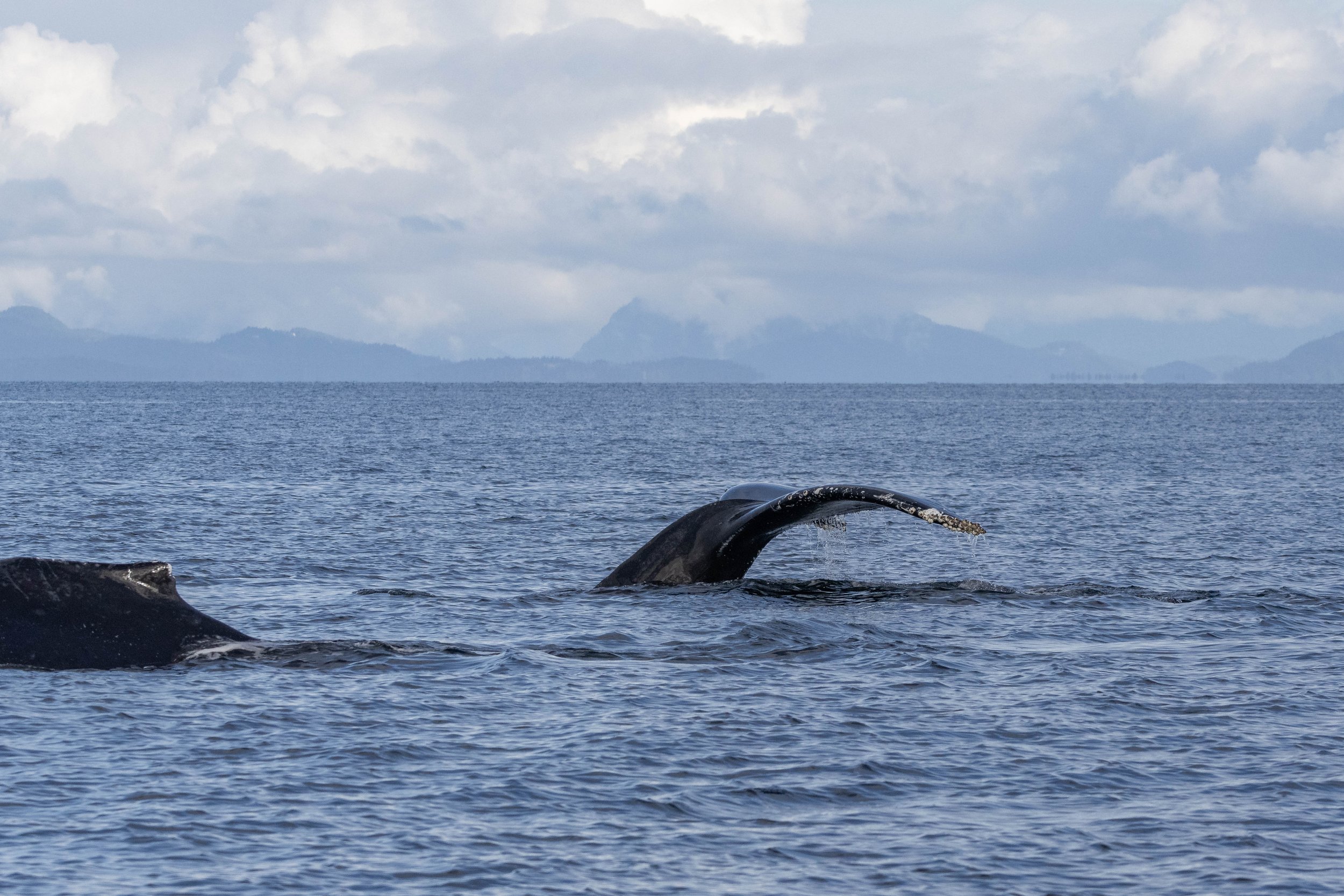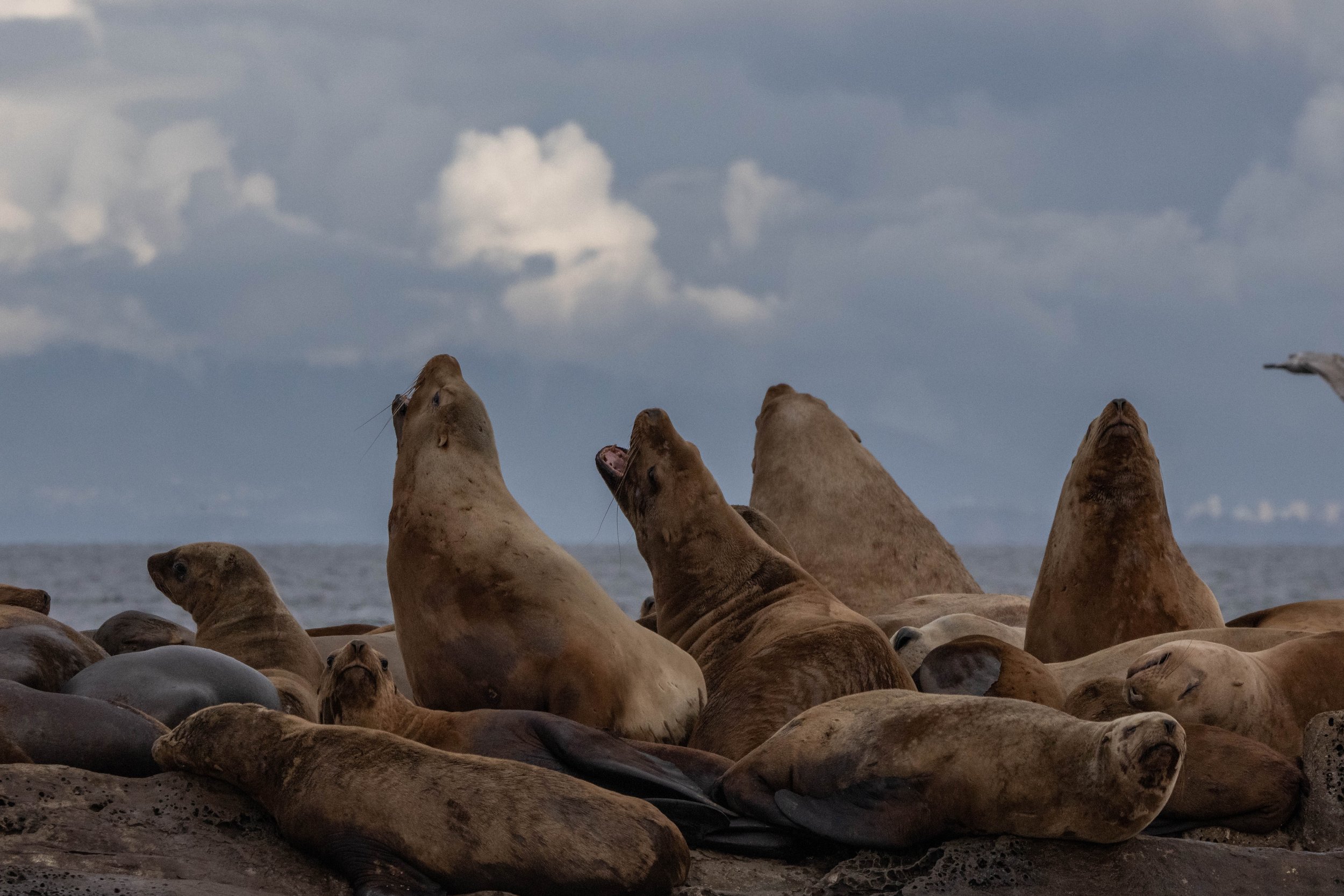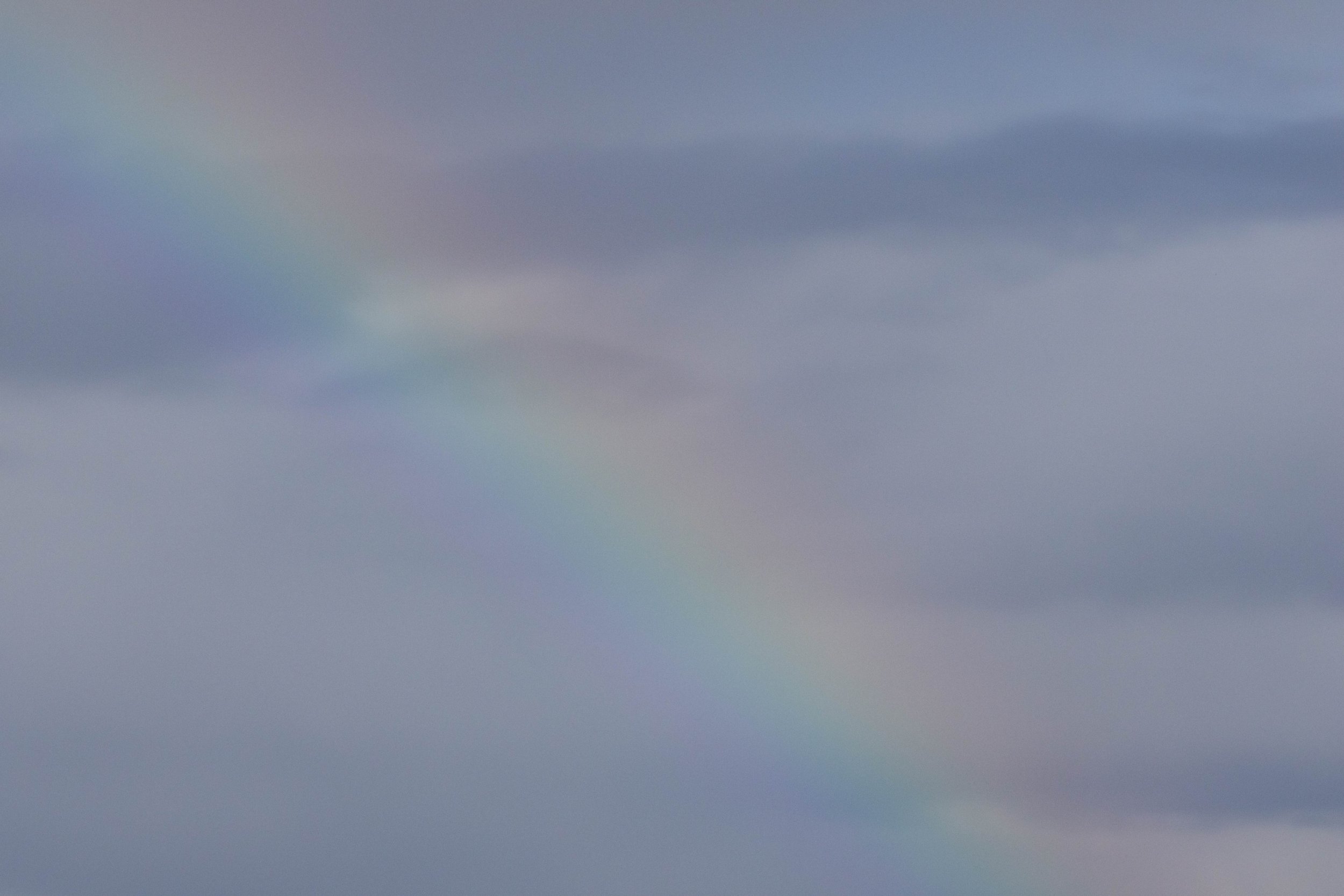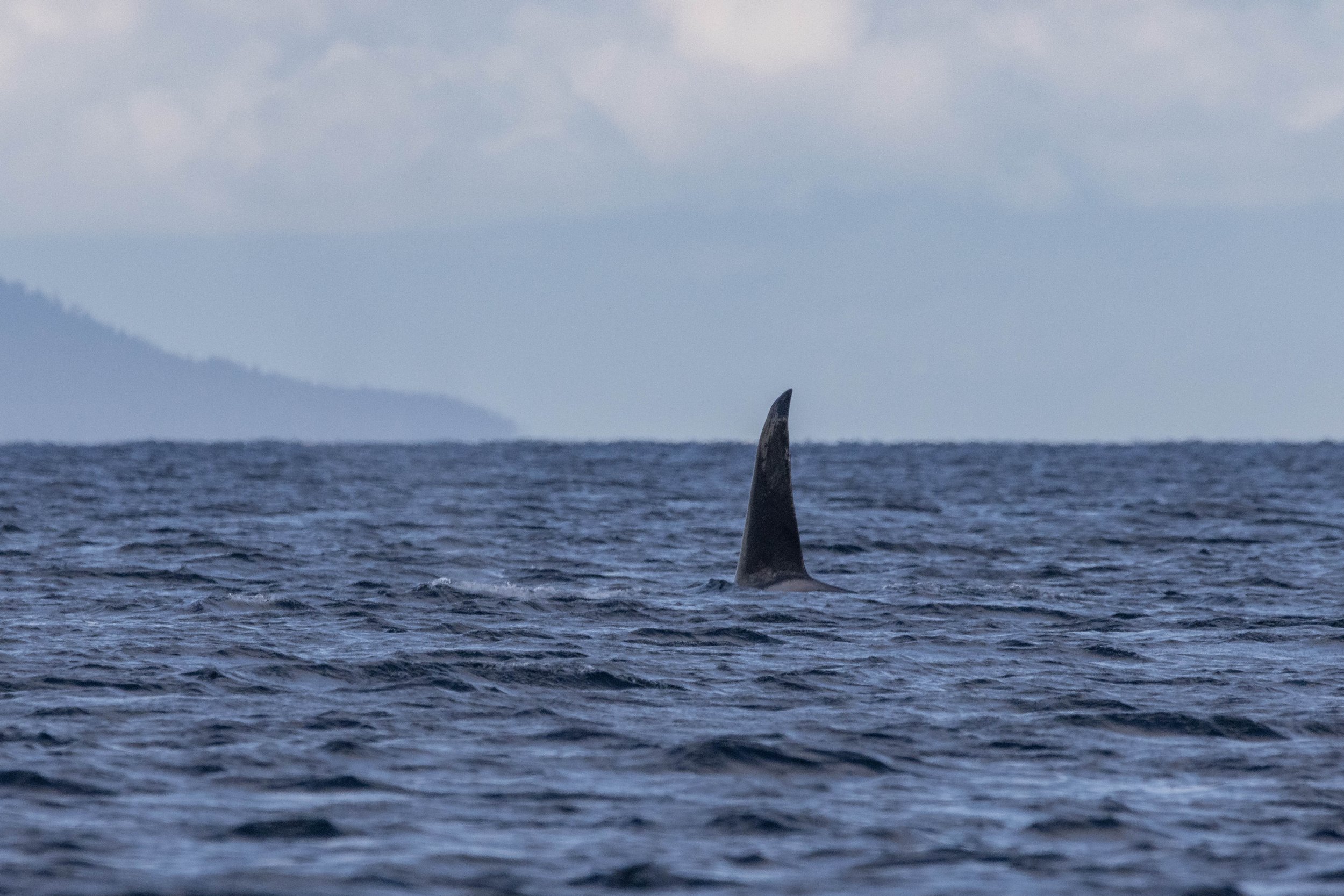October 29, 2024 - Humpbacks Near Gabriola, and some tricky Orca close to home
We started our day by heading into the Strait of Georgia, into the more open waters between Vancouver Island and the mainland of BC that had been very popular for the whales lately. We had our eyes peeled for any of the telltale signs of whales, the tall blows released as they exhale at the surface, tails being lifted from the water, or the towering black dorsal fins of the orca. As we travelled a buzz of excitement came across the boat as our captain spotted blows in the distance…we had found some whales!
As we approached the area we had seen the misty exhales from the whales, it became clear that this was a pair of humpbacks. They seemed to be feeding in the area, lifting their 20-foot-across tails high into the air before slipping below the waves in search of their food. Here they are likely feeding on primarily Krill, with some of the small schooling fish in the mix as well. We can get an idea of what the humpbacks eat based on their poop. When they defecate, they do it at the surface, sometimes giving us a great view of it. It typically looks pink in colour with our humpbacks, meaning that there is a high portion of Krill that they are eating. Researchers get more detailed information about their diet by collecting samples of these feces left by the whales. The hard parts of their prey are left behind in the poop, from the hard exoskeletons of the krill to the bones of the small fish. Experts look at these leftovers and can identify those microscopic animals down to the species level. It’s quite amazing work!
Today we weren’t lucky enough to see poop at the surface, but these deep feeding dives made it easy for us to snap a photo of the underside of these whale’s tails that we need to be able to ID them. The onboard Naturalist quickly figured out that these two were Fader (BCY0195) and Octo (BCX1920) travelling together. We spend some time with these two before leaving them to their food, eager to see what else the Salish Sea might have in store for us. Our next stop was at a popular haul-out spot for Steller Sea Lions and Harbour Seals: Stinky Rocks! Today the tide was quite high, hiding the rocks that the Harbour Seals would usually be using under the surface so we only saw their shiny heads watching us float by from the water. The Steller Sea Lions were still clinging on to the last of the rocks here, fighting amongst themselves and generally causing the ruckus that we have come to expect from them here. They make noises similar to growling, roaring, and sometimes burping sounds which can be very entertaining to listen to. They are also impressive to look at, as we had multiple large, adult males spending time on the rocks here today. They reach massive sizes as adults, with males weighing in at up to 2,800 pounds and females at an impressive 800 pounds. There were also some birds sharing the rocks with these giants, including the sleek, black cormorants, and the crow-sized Black Oystercatchers with their vibrant orange beaks.
After enjoying our time with the entertaining animals on Stinky, we ventured further out into the Strait of Georgia in search of more whales. It didn’t take long before we found one, and it turned out to be a very interesting encounter. It was a whale that we immediately recognized, and not necessarily for good reason. Schooner (BCX1193calf2021) is a young humpback whale that was believed to have been struck by a propeller early in the season, severing part of his tail. We have been avoiding spending time with him during our tours to try and minimize any possible negative impact that our noise or general presence might have on his healing process, but today he seemed to have different ideas. Before we could safely leave him to his travels, he approached our vessel. This happens once in a while, a curious behaviour from the humpbacks that we call “mugging”. Schooner and the rest of his family are known for this behaviour, which likely led to Schooner’s injury. Close proximity to boats like ours that have the training and recognize the behaviour as curiosity and not aggression know to just sit there and wait until the whale’s curiosity is satisfied won’t be too bad, but having these massive animals approach your vessel might be frightening if you didn’t have prior interactions with them. This injury is a reminder to give these animals space when watching them, and being prepared to wait it out if they ever approach.
That’s exactly what we did today, as Schooner circled our vessel for a few minutes before moving on. We got some really detailed photos during this encounter of his injury that will be important for tracking his healing process! They will be included at the very end of the photos for this blog since they are a little tough to look at.
While Schooner was keeping us floating in the water with our engines off, the captain got word of a pod of orca that were just spotted from shore right outside the Nanaimo Harbour! Once Schooner got bored of us, we left him behind and headed out to find these whales, with the help of another Vancouver-based vessel. This is a great area to whale watch, as there is a lot of cooperation between companies. Working together to search doubles your chance of finding something after all! Today it was this vessel that found the whales. It was a pod of 4 orca travelling north in two pairs. Looking at the male, it seemed we had one of the more difficult whales to ID around here thanks to two whales looking nearly identical. After closer inspection of the photos, it turned out to be Yelnats, a member of the T060s.
T060 Panthera ♀ (~1980)
T060C Yelnats ♂ (2001)
T060F Tigris ♀ (2012)
T060G Uncia ♀ (2019)
Yelnats has a nearly identical notch from his dorsal fin as T123 Stanley (Yelnats is Stanley backwards, get it?)! Our blog from August 30th, when we last saw the T060s, outlines some of their differences well. Today these whales were broken into two pairs. We spent time with Yelnats and Panthera travelling together, while the younger two were about a mile away, heading in the same direction. It’s very common to see this spread in the Biggs Orca, as spreading out increases their chances of coming across an unsuspecting seal or sea lion for a snack! We travelled with them for a while, before our time started to run out. We left them heading north, and we started the journey back to the Harbour. It was a great day spent on the water, getting to see both species of whales in addition to all the other wildlife! The photos from the tour taken by onboard Marine Naturalist Vanessa Vereschahen can all be viewed below!
Octo arching their back for a dive.
The underside of Octo’s tail.
The underside of Fader’s tail.
Fader in front of Octo.
Octo going for a dive.
The underside of Octo’s tail.
A nice high fluke from Octo.
Octo’s dorsal fin.
Octo diving with Fader surfacing beside him.
A Bald Eagle in flight.
Harlequin ducks swimming by.
Cormorants on Stinky Rocks.
Black Oyster Catchers.
Steller Sea Lions at Stinky.
Roaring sea lions.
A rainbow overhead.
T060C Yelnats surfacing in the waves.
T060C Yelnats’s dorsal fin.
T060C Yelnats breaking through the water.
T060C Yelnats with the Sunshine Coast behind him.
A great look at the scars on T060C Yelnats’s saddle patch that help us differentiate him from his look alike.
T060C Yelnats fighting through a wave.
T060C Yelnats with a little but of his eye patch showing.
T060 Panthera surfacing in the waves.
Encounter with Schooner
Warning: Some Graphic Images
Schooner Arching for a dive.
Schooner diving, giving us a good look at the scar forming over his injury.
Schooner’s Dorsal fin as he approached the boat.
The tubercles and nostrils visible on Schooner as he surfaced.




























